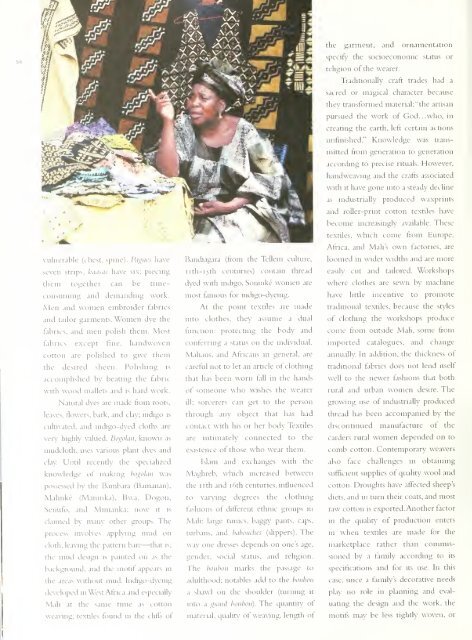SCOTLAND - Smithsonian Digital Repository - Smithsonian Institution
SCOTLAND - Smithsonian Digital Repository - Smithsonian Institution
SCOTLAND - Smithsonian Digital Repository - Smithsonian Institution
You also want an ePaper? Increase the reach of your titles
YUMPU automatically turns print PDFs into web optimized ePapers that Google loves.
the garment, and ornamentation<br />
56<br />
specif)' the socioeconomic status or<br />
rehgion of the wearer.<br />
Traditionally craft trades had a<br />
sacred or magical character because<br />
they transformed material; "the artisan<br />
pursued the<br />
work of God... who, in<br />
creating the earth, left<br />
certain actions<br />
vulnerable (chest, spine). Pagiics have<br />
seven strips, kaasiis have six; piecing<br />
them together can be timeconsuming<br />
and demanding work.<br />
Men and women embroider fabrics<br />
and tailor garments. Women dye the<br />
fabrics, and men polish<br />
them. Most<br />
fabrics except fine, handwoven<br />
cotton are polished to give them<br />
the desired sheen. Polishing is<br />
accomplished by beating the<br />
fabric<br />
with wood mallets and is hard work.<br />
Natural dyes are made from roots,<br />
leaves, flowers, bark, and clay; indigo is<br />
cultivated, and indigo-dyed cloths<br />
very highly v;ilued.<br />
are<br />
Bogolaii, known as<br />
mudcloth, uses various plant dyes and<br />
clay. Until recently the speciahzed<br />
knowledge of making hogclaii was<br />
possessed by the Bambara (Bamanan),<br />
Malinke (Maninka), Bwa, Dogon,<br />
Senufo, and Minianka; now it is<br />
claimed by many other groups. The<br />
process involves applying mud on<br />
cloth, leaving the pattern bare—that is,<br />
the mud design is painted on as the<br />
background, and the motif appears in<br />
the areas without mud. Indigo-clyeing<br />
developed in West Africa and especially<br />
Mall at the same time as cotton<br />
weaving; textiles found in the cliffs ot<br />
Bandiagara (from the Tellein culture,<br />
iith-isth centuries) contain thread<br />
dyed with indigo. Soninke women are<br />
most famous for indigo-dyemg.<br />
At the point textiles are made<br />
into clothes, they assume a dual<br />
function: protecting the body and<br />
conferring a status on the individual.<br />
Malians, and Africans in<br />
general, are<br />
careful not to let an article of clothing<br />
that has been worn fall in the hands<br />
of someone who wishes the wearer<br />
ill; sorcerers can get to the person<br />
through any object that has had<br />
contact with his or her body. Textiles<br />
are intimately connected to the<br />
existence of those who wear them.<br />
islam and exchanges with the<br />
Maghreb, which increased between<br />
the nth and 1 6th centuries, influenced<br />
to varying degrees the clothing<br />
fashions of different ethnic groups m<br />
Mali: large tunics, baggy pants, caps,<br />
turbans, and Ihihouclics (slippers). The<br />
way one dresses depends on ones age,<br />
gender, social status, and religion.<br />
The houhou marks the passage to<br />
adulthood; notables add to the boiihoii<br />
a shawl on the shoulder (turning it<br />
into a ^qrand boubcu).The quantity of<br />
material, equality of weaving, length ot<br />
unfinished.'" Knowledge was transmitted<br />
from generation to generation<br />
according to precise rituals. However,<br />
hanclweaving and the crafts associated<br />
with it have gone into a steady decline<br />
as industrially produced waxprints<br />
and roller-print cotton textiles have<br />
become increasingly available. These<br />
textiles, which come from Europe,<br />
Africa, and Mali's own factories, are<br />
loomed in wider widths and are more<br />
easily cut and tailored. Workshops<br />
where clothes are sewn by machine<br />
have little incentive to promote<br />
traditional textiles, because the styles<br />
of clothing the workshops produce<br />
come from outside Mah, some from<br />
imported catalogues, and change<br />
annually. In addition, the thickness of<br />
traditional fabrics does not lend itself<br />
well to the newer fashions that both<br />
rural and urban women desire. The<br />
growing use of industrially produced<br />
thread has been accompanied by the<br />
discontinued manufacture of the<br />
carders rural women depended on to<br />
comb cotton. Contemporary weavers<br />
also f'^ice challenges in obtaining<br />
sufficient supplies of quality wool and<br />
cotton. Droughts have affected sheep's<br />
diets, and in turn their coats, and most<br />
raw cotton is exported. Another factor<br />
in the quality of production enters<br />
in when textiles are made for the<br />
marketplace rather than commissioned<br />
by a family according to its<br />
specifications and tor its use. In this<br />
case, since a family's decorative needs<br />
play no role in planning and evaluating<br />
the design and the work, the<br />
motifs may be less tightly woven, or
















